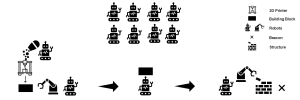project09:2024Msc2JIP: Difference between revisions
JIPStudent (talk | contribs) |
JIPStudent (talk | contribs) |
||
| Line 32: | Line 32: | ||
== 3D | == 3D Printing == | ||
== SWARM ROBOTICS == | == SWARM ROBOTICS == | ||
Revision as of 15:46, 14 November 2024
MSc 2 JIP Space Architecture & Infrastructure
The Lunar Constructors project is aimed at addressing one of the most pressing challenges in space exploration: creating sustainable, autonomous habitats on the lunar surface. As space agencies and private companies advance their capabilities for lunar missions, the goal of establishing long-term human presence on the Moon is becoming more tangible. However, the Moon's environment presents extreme challenges—including intense radiation, a lack of atmosphere, severe temperature fluctuations, and the impact of micrometeorites—that make traditional human-centric construction methods risky and complex.
The project addresses these challenges by proposing an autonomous, modular system for constructing lunar habitats, utilizing local resources and advanced robotic and manufacturing technologies. The project's approach combines three key technological domains:
- Building Blocks: For building a very basic structure on the Moon, the Lunar Constructors use a very basic part of a structure, the building blocks. For a structure to be established by a swarm of robots, the building blocks required to be assembled should be simple structures to decrease the complexity of assembling the structure by the robot. Another aspect to be considered is the complexity involved with 3D printing, hence choosing a building block which is simple yet strong is very important.
- 3D Printing: Additive manufacturing methods, specifically adapted for lunar conditions, are used to transform regolith into interlocking building blocks. Techniques such as binder jetting and selective laser sintering allow the creation of complex structures that are lightweight yet resilient, accommodating the Moon's low gravity and atmospheric conditions.
- Swarm Robotics: Employing a decentralized system of robots that work collaboratively, each robot is designed to perform specific tasks, such as regolith collection, transportation, and assembly. Inspired by swarm intelligence, this autonomous approach allows a large number of small robots to adapt dynamically, perform tasks collectively, and compensate for any individual failures—critical attributes for construction in the harsh lunar environment.
The Lunar Constructors project tries to address the feasibility of lunar construction through a series of targeted objectives. This includes researching future robust 3D printing processes using lunar regolith simulants, designing efficient robot interactions for swarm-based construction, and simulating the assembly of various structures within the Gazebo simulation environment. The project also evaluates potential building designs, such as pyramidal and dome-shaped structures, which are suited to the lunar environment's unique demands.
By leveraging advanced autonomous systems and local materials, Lunar Constructors aims to contribute significantly to global efforts in space exploration. This project offers a scalable, sustainable approach to lunar habitat construction, helping to pave the way for future missions and long-term human presence on the Moon.
Problem Statement
The project aims to perform a feasibility study of setting up a structure on the surface of the Moon by using in-situ resources to 3D print the structure and assembling it using a swarm of robots.
Concept of Operations
A general concept of operations was developed to have a clear perspective of the mission. Figure 1 illustrates the concept of operations of the Lunar Constructors project. As illustrated in the figure, from the swarm of robots available, one of the robots collects lunar regolith, which is fed to a 3D printer to produce blocks for the structure. The blocks are then transported to a site by the robots, where they use their swarm intelligence to build a structure using a predefined rule set.

BUILDING BLOCKS
For the project, interlocking blocks were chosen as the preferred building component for constructing autonomous, durable structures on the Moon. These blocks are designed to simplify the assembly process, providing a stable and adaptable modular unit that a swarm of autonomous robots can handle and stack effectively. The interlocking blocks offer unique advantages in both structural integrity and ease of manipulation, making them particularly suitable for the challenging conditions of the lunar environment.
The interlocking blocks are engineered with simple yet effective connectors that allow each block to securely interlock with adjacent units. This design enables a robust stacking system that holds up well under the Moon’s low-gravity conditions. An illustration of the interlocking building blocks are shown below.
3D Printing
SWARM ROBOTICS
FINAL REVIEW